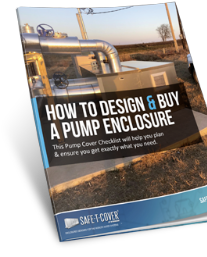If you’re considering installing a pump cover (or pump enclosure) over your pump, there are some things to consider. Everything from the type of pump to the stage your project is in will determine where and how your piping penetrations will be made. But there’s one way to do it that stands out above the rest.
If you’re covering pumps on a consistent basis, you understand that they usually have piping that runs to and from them and they come in different sizes or travel in different directions.
You may also deal with things like electrical conduits or wires that power the control panel, motors, heaters, and fans to keep equipment running in and out of your pump cover.
So, let’s look at the best course of action when planning for piping penetrations and find out which practice works best.
Questions To Ask About Pipe Penetrations
Before your pipe penetrations are cut, there are several questions you should ask. Always find out:
- How many pipe penetrations will I need?
- What is the diameter of each piping penetration?
- Where will they need to be positioned on the pump enclosure?
You should also determine if the pump cover manufacturer or the installing contractor will be creating the piping penetrations. And find out if the piping will be installed before (or after) the pump cover is set in place.
Early Stage Pipe Penetrations
Ideally, your pump enclosure project is in its initial stages and piping can be installed after the pump cover is set in place. This allows the installing contractor to know exactly where to position your pipe penetrations. It also lessens the chance for having to re-do them or worse yet having to purchase a replacement pump cover panel.
If your project is further along, or you’re covering a pump that is already in place, you'll need a “U-shaped” penetration in the panel(s) so that it can slip over the existing piping. This type of penetration will leave a void below the piping that will need to be filled in with an insulated patch to maintain the heating capability of the pump cover.
Aluminum Pump Enclosures Are Best
Aluminum enclosures make it possible to cut the holes you need on-site. All you need is a handheld jigsaw and a template. This is especially true for pump covers. So, an aluminum enclosure that has the piping penetrations cut in the field is the best way to get it right every time.
Now that you know how to go about making pipe penetrations, next time we’ll talk about the best way to fill in the gaps around them.
In the meantime, you can learn why a custom pump enclosure is often a more cost-effective option than buying a standard enclosure. Check out our guide “How To Buy A Custom Enclosure.” This checklist will show you the necessary steps for designing and buying a custom pump enclosure.





